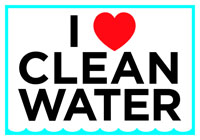
By Cecily Savick, Clean Water Action Volunteer
The referenced media source is missing and needs to be re-embedded.
This post originally appeared at MLive.com
Clean Water Action is mobilizing thousands of members and volunteers, like myself, to help put stop to water pollution from power plants. I've seen first hand how vulnerable people are to coal plant pollution in our air, my daughter and husband both have asthma.
It doesn’t take much imagination to see a smokestack and know that what’s coming out of it is dirty. It is, though, harder to see how that burning coal ends up in our waterways, including the Great Lakes.
Here’s how: power plants burn coal to produce electricity. What’s left over after burning this coal either goes up a smokestack or is residue in the machine. The coal ash leftover is dumped into our water.
Now, the utilities have some limits on how much of this coal ash – laced with arsenic, mercury and lead – can go into the water, but the limits aren’t much. A power plant in Monroe used to be able to dump unlimited amounts of these toxic chemicals into the water, but in 2010 they were still dumping 57.5 million gallons a day.
As stewards of 20 percent of the world’s freshwater supply, we simply can’t allow this kind of harm to continue.
A recent report cited 16 power plants in Michigan that dump these toxins into our water. Consumers Energy, in a July 24 MLive article, disputed the report saying Michigan regulates coal ash as “non-hazardous waste.”
First of all, shame on Michigan for deeming this toxic garbage non-hazardous. Second of all, Consumers’ excuse it’s in compliance with existing government regulations ignores the fact these regulations don’t protect Michigan’s waterways enough.
Remember the 57.5 million gallons of toxic wastewater I just mentioned? Those are existing regulations. More than half of all toxic water pollution in our country comes from power plants, making coal- fired power plants the number one source of toxic water pollution in the United States, according to the U.S. Environmental Protection Agency.
The EPA hasn’t changed these rules in more than 30 years, but this summer the agency proposed new limits, known as Proposed Effluent Guidelines. The public has a chance to weigh in on these new safeguards through Sept. 20.
The EPA did this because nearly 140,000 people every year experience increased cancer risk because of arsenic in fish from coal plants. Another 13,000 children under the age of seven every year have reduced IQs because of lead in fish they eat, and almost 2,000 children are born with lower IQs because of mercury in fish their mothers have eaten.
So Consumers Energy is accurate when it says it’s abiding by the current government regulations, but if you dig a little deeper, you can understand how these regulations aren’t doing us a whole lot of good right now.
Thankfully, the EPA is doing the right thing and establishing new safeguards for our waterways and our health.Related Posts
Stay Informed
Get the latest updates and actions:
Thanks for signing up!
There was a problem processing your signup. Please try again.


